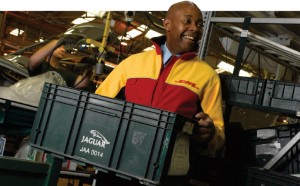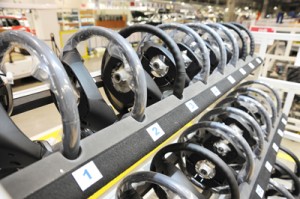Is there still a place for leaders?
The ‘lead logistics provider’ concept may be undergoing its biggest ever changes. The question is whether or not it is still working for today’s automotive industry.
 Co-ordinated from a ‘control tower’ based on the customer's site in Solihull, England, an extensive European supply chain feeds the three British vehicle assembly plants of Jaguar Land Rover. Each week, some 43 carriers make around 1,950 collections from 470 suppliers in 18 countries, delivering full vehicle loads containing the components direct to JLR's Halewood, Solihull and Castle Bromwich plants.
Co-ordinated from a ‘control tower’ based on the customer's site in Solihull, England, an extensive European supply chain feeds the three British vehicle assembly plants of Jaguar Land Rover. Each week, some 43 carriers make around 1,950 collections from 470 suppliers in 18 countries, delivering full vehicle loads containing the components direct to JLR's Halewood, Solihull and Castle Bromwich plants.
Full load trailers containing parts for all three JLR plants also deliver direct to a UK crossdock in Hams Hall. Meanwhile, less-than-full trailer load volumes are consolidated via seven consolidation crossdocks spread across the continent. From these, the components are dispatched to the crossdock in Hams Hall, before feeding JLR’s plants.
It is a complex piece of choreography, making use not only of logistics assets owned by multiple logistics providers, but also the logistics networks of other manufacturers – both automotive and non-automotive. All of these operations are managed, on behalf of Jaguar Land Rover, by DHL Supply Chain, which also operates a large part of the network, including the crossdocks and line feeding.
It is precisely for such choreography that carmakers have looked to lead logistics providers (LLPs) such as DHL to exploit their assets, size, knowledge and contacts, in order to construct and manage more effective networks than most OEMs could achieve on their own.
As such, an LLP is neither a third party logistics provider (3PL) – procuring or controlling transport on behalf of a manufacturer – nor is it, depending on your definition, a ‘fourth party logistics provider’ (4PL) – assuming management, administrative and purchasing functions over transport without owning or operating assets. Rather it is something in between that also carries out roles performed by each. It manages, designs and aggregates, but will also – as DHL does for Jaguar Land Rover – commit its own assets and people to the task, alongside those of third parties.
Joannes Van Osta, general manager for group transport and logistics at construction and agricultural equipment manufacturer JCB, sums up the role of an LLP succinctly. “For me, a lead logistics provider is a mix between a 3PL and a 4PL: a supply chain orchestrator and architect, but with its own backbone of services and assets on offer.
“Like a 3PL, the LLP will utilise some of their own organisation’s services, but only where these add real value for their customer over and above what is available within the open market,” he continues. “A 4PL, to stay true to the original meaning of the term, should have no assets whatsoever.”
Moreover, just like a 3PL, an LLP possesses an insight into other automotive manufacturers’ operations and any synergistic opportunities these might suggest – but is also, like a 4PL, incentivised to bring these opportunities to the automotive customers’ attention. Indeed, unfettered by concerns that manufacturers may have about sharing information with competitors, LLPs and 3PLs are arguably better positioned to spot such opportunities.
“Both of our current providers have brought to the table some potential opportunities and we encourage them to do so,” says Dana McBrien, associate chief advisor for North American logistics at Honda of America Manufacturing. “Since these companies have the ability to see multiple automotive manufacturers’ networks, it gives them the opportunity to see supplier and network overlap, and create mutually beneficial proposals that involve multiple manufacturers and their own company assets.”
No wonder, then, that the LLP model has proved so popular. It allows automotive manufacturers to focus on their core competency – manufacturing – while enabling them to still benefit from the core logistics competencies of LLPs.
"Strong LLP models are a true partnership between customer and supplier. The most successful implementations that we have are those when you can’t really tell the difference between supplier and customer" - Jeff Bullard, Penske Logistics
“Manufacturers have discovered that their fear of losing control was unfounded,” says Jeff Bullard, senior vice-president of operations for the US central region at Penske Logistics, referring to the unwillingness of some companies to outsource such management to a logistics provider.
“Strong LLP models are a true partnership between customer and supplier. The most successful implementations that we have are those when you can’t really tell the difference between supplier and customer: both companies are driven by the same metrics and collaborate together on success.”
A model with wide appeal – and disagreement
The LLP model is found across the industry. General Motors has a very prominent model in North America, for example, using Ryder Logistics to manage inbound material for its US and Canadian plants, while using Penske Logistics to manage similar deliveries to Mexico. The carmaker’s global head of logistics, Edgard Pezzo, has told this magazine that he is also interested in possibly extending aspects of this model to other regions.
Yet for all the benefits an LLP can provide, you don’t have to look too far to come across instances where automotive manufacturers are backing away from the once all-conquering LLP model, or at least using more of a mix between providers.
At the Chery Jaguar Land Rover joint venture in China, for instance, management has chosen not to replicate Jaguar Land Rover’s single LLP model, but instead appointed one LLP to handle domestic logistics and another to handle international logistics from Europe (neither of which is DHL, by the way).
Ford, to cite another example, officially uses Penske Logistics across North America, except in Mexico, where the carmaker uses a mix of local specialisation and other providers, including DHL. Chrysler, on the other hand, has specifically looked to take some in-plant logistics and sequencing back in-house from LLPs.

Volvo Cars used to outsource its entire function to what was then called Volvo Logistics (part of the commercial vehicle OEM, Volvo Group), a mixed asset and management provider, but has now built up an in-house logistics management and procurement team for inbound and outbound.
Toyota has also shied away from LLP arrangements. In North America, the carmaker has recently centralised its logistics routing and engineering; whereas it once left that mainly to its plants, which in turn outsourced to LLPs, those contracts have mostly been coming back in-house.
Others, meanwhile, have tended to create something like an in-house LLP (or 4PL, again depending on your definition). The Volkswagen Group, with its ‘Volkswagen Logistics’ group function, comes to mind. With more than 100 plants inside the wider group, group logistics bundles together shared suppliers and global flows across them all, combining to gain economies of scale and also to look for shared routes.
Compared to the scenario at JLR, a Volkswagen operation will often have a more diverse pick of logistics providers contracted either directly through the plant or group logistics. So, for VW’s production in the US, Ryder operates the company’s regional warehouse, close to its Chattanooga, Tennessee plant and also manages inbound routes from suppliers to the warehouse. Overseas imports are handled by Kuehne + Nagel, which delivers containers to a warehouse on site, managed by Team 3 Logistics, a joint venture between Schnellecke Logistics and Chattanooga-based Kenco.
Moreover, adds Bill Garrett, president and chief executive at logistics service provider Vascor, there are huge differences in how automotive manufacturers and LLPs structure their respective relationships with each other. While it’s easy to talk about the ‘LLP model’, it’s much harder to pin down a definitive description of what that model looks like.
“There are a number of different models out there, with different approaches to carrier contracts, pricing schemes, IT connectivity and automotive manufacturers’ management and payment preferences, with some manufacturers wanting to pay 3PLs directly and others wanting the LLP or 4PL to pay 3PLs,” observes Garrett. “Across the board, there are huge differences – and it’s continuing to evolve.”
How to maintain trust
All of this raises questions about whether the LLP model is still relevant and fit for purpose in today’s automotive supply chain. Some changes are clearly visible, so is it a sign of a broken system or one that is simply undergoing the sort of evolutionary change that impacts most industry-wide initiatives over time?
Talk to insiders and various views emerge. The bottom line: the LLP model isn’t a ‘one-size-fits-all’ panacea for automotive supply chains. Nor is it a static, unchanging model: more than at any time in the recent past, there’s an undeniable fluidity around what the marketplace is looking for and what LLPs are offering. Finally, there’s a greater appreciation of the risk and downsides of going down the sole LLP route.
An example of which is that same inbound logistics LLP contract operated by DHL Supply Chain on behalf of Jaguar Land Rover. With an LLP handling inbound logistics and, in this case, in-plant logistics in their entirety, continued vehicle production at the automotive manufacturer depends on good industrial relations at the LLP. For JLR, those relations came close to breaking down in mid-2013, when the union that represents DHL Supply Chain workers threatened strike action, prompted by pay disparities with Jaguar Land Rover’s directly employed personnel.
 "You often find that plant management will claim an idea as theirs, while the LLP will argue that it was its idea, [so] it becomes problematic as to how the savings should be shared"
"You often find that plant management will claim an idea as theirs, while the LLP will argue that it was its idea, [so] it becomes problematic as to how the savings should be shared"
- Michael Silvio, Cooper Standard
Nor is it solely in industrial relations where an LLP might be perceived as increasing an automotive manufacturer’s exposure to risk. Vascor’s Garrett points to freight capacity tightening in both the US road and rail networks as a factor, too. When it is so difficult to secure transport capacity, some OEM executives raise the question of whether a ‘middle man’ is really the right way to go about getting it.
“The rail network in the United States has been slowing down for a year and now it’s jammed up – so traffic has been moving to trucking and now trucking has also become jammed up,” he asserts. “As a result, the pure freight brokerage model is breaking down and we’re seeing customers saying: ‘If you don’t have assets, we’re not interested in talking to you.’ Our belief is that we’re going to see LLPs come under pressure to become more asset-based.”
The latter is perhaps one reason why the LLP has never really taken off in a substantial way for outbound vehicle logistics, where providing transport capacity at the lowest price has often been the priority. In this case, even some in-house providers – including Volkswagen Logistics and Glovis for Hyundai-Kia – have taken direct control of assets whether on leases, time charters or outright purchases.
Not all children play together nicely
Another source of tension and eventual risk lies in the way that many LLP contracts are incentivised, say industry insiders. They argue that so-called ‘gain-sharing’ deals lead to conflicts of interest around where the credit for particular cost savings is due.
“It’s too easy for LLPs to claim the credit for ideas that didn’t originate with them, and thus get an enhanced share of the savings,” says Mark Ellis, global industry director for automotive at logistics service provider Geodis Wilson. “The real loser is the automotive manufacturer, whose share of any gains is correspondingly reduced.”
It’s a view shared by Michael Silvio, director of supply chain management at tier supplier Cooper Standard. Not only is the gain-sharing business model open to abuse and disputes over where improvements actually originated, he observes, but it also introduces a potentially counter-productive adversarial element to the relationship between an LLP and its customers.

“What you often find is that plant management will claim an idea as theirs, while the LLP will argue that it was its idea, with the result that it becomes problematic as to how the savings should be shared,” he notes. “It’s just like kids – not all kids play well together. Some companies aren’t always good at managing the relationships that they have with partners.”
What’s more, he adds, having too great a focus on cost savings can obscure the merits of having a well-run supply chain that delivers on its original objectives. “For automotive manufacturers, it can sometimes be a question of ‘what have you done for me lately?’” sums up Silvio. “The first year of a contract, the LLP saves them $14m, the second year it saves them $7m and the third year, $2m. Come the fourth year, the LLP says that the well is dry and the automotive manufacturer then switches providers. That is disruptive.”
Knowing when to offer a little, or a lot
Such niggles should be balanced against LLPs’ readiness to adapt their own offerings, on a case-by-case basis, to meet the needs of their automotive customers. Moreover, they point out, it is this readiness to adapt that at least partially lies behind the evolution being seen in how manufacturers make use of LLPs.
“The different LLP models emerge because companies have different needs,” observes Silvio. “The first step when considering an outsourcing relationship is to perform a self-assessment and determine what your firm is good at, what tasks you want to keep in house and which you desperately need to outsource. Each company will find themselves in a slightly different situation and the LLPs will design a solution that fits their individual needs.”
Furthermore, adds Lee Jones, vice-president of customer development and marketing at Vascor, automotive manufacturers also view their individual core competencies differently. “Toyota, for instance, considers its downstream supply chain to be an extension of its Toyota Production System and has therefore in-sourced a lot of potential LLP activity,” he notes. “Others take the opposite view and regard the LLP as the expert in logistics, and want to leverage that expertise for their own supply chains.”
Consequently, stresses Paul Parry, global LLP vice-president at DHL Supply Chain, it’s important for an LLP to be able to respond across a broad spectrum of capabilities, ranging from value-added services such as in-plant kitting and sub-assembly, right through to transport and warehouse procurement and freight moving. “A lot depends on the starting point and what the customer wants to achieve,” he emphasises. “You can’t go out with a single LLP proposition that you want to sell: it’s about listening, staying flexible and responding to the customer’s requirements.”
This is a view echoed by Dick Jennings, senior vice-president for supply chain solutions at logistics provider Ryder. Automotive manufacturers know their own requirements best, he asserts, and the role of the LLP is to respond – hence the range of different LLP models in the marketplace. “At Ryder, we have moved from simple route-planning to responding to each of these LLP models and in the process making our service offering both broader and more modular,” he says. “We can be involved in procurement, planning, or execution – and either individually, or together. Whereas once we simply planned individual routes, today we’re planning entire networks or pre-planning for new vehicle models that are three or four years away from launch. It’s down to the customer to determine how they choose to utilise us.”

That said, adds DHL’s Parry, the broad trend in today’s marketplace is towards greater ‘hands-on’ customer involvement. Consequently, he explains, DHL Supply Chain operates only rarely at the two extremes of the LLP model – the ‘4PL with no 3PL role’ and the ‘fully-integrated, do-almost-everything’ offering typified by its Jaguar Land Rover contract. Instead, he says, DHL will either operate as the lead network manager while fulfilling certain lanes and functions itself, or alternatively combine traditional 3PL activities alongside in-house value-adding functions.
“In the past, transport procurement was seen as core to the LLP role: going out to the market, contracting with 3PLs and paying the carriers,” he notes. “That still happens, but some customers prefer to do things differently and will purchase the transportation themselves, with us doing the co-ordination, management and network design.”
Despite the undoubted improvements and cost savings that LLPs have delivered, there are ample opportunities to do more still, reckon industry observers. Vascor’s Lee Jones, for instance, points to the largely untapped opportunities to be found when both carmakers and tier one suppliers combine to develop integrated freight networks.
To be sure, the automotive industry could look exclusively to LLPs to deliver that integrated future, alongside other efficiencies and improvements, but LLPs aren’t the only way of achieving this, stresses Cooper Standard’s Silvio. “The LLP model isn’t for everyone. Some companies do not work well with strategic partners, or may wish to keep the skill set in-house as a competitive advantage. After all, it is still possible to negotiate directly with carriers without an LLP.”
Just as it’s possible for automotive manufacturers to negotiate directly with logistics service providers, it’s equally possible for them to tap into the same logistics skills as LLPs, Silvio asserts: “The 3PLs have become a great source of logistics analysts who can hit the ground running and quickly find opportunities to improve your supply chain – if you can get them to leave the 3PL and try the other side of the desk.”
Christopher Ludwig contributed to this report
This article has been updated to correct initial errors in describing the makeup of the European inbound supply chain that DHL manages on behalf of Jaguar Land Rover.





